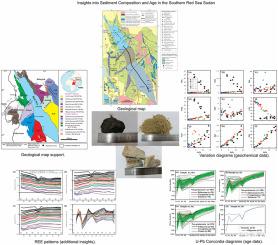苏丹红海南部海滩沉积物的地球化学和碎屑锆石U-Pb年代学:古风化和物源意义
IF 4.1
3区 地球科学
Q2 GEOSCIENCES, MULTIDISCIPLINARY
引用次数: 0
摘要
红海等活动裂谷盆地为研究沉积物动力学提供了天然实验室,对全球物源和资源勘探具有重要意义。本研究将地球化学和碎屑锆石U-Pb年代学结合起来,研究了苏丹红海沿岸的海滩沉积物,这是新元古代阿拉伯-努比亚盾(ANS)内的裂谷边缘。已经观察到三种砂沉积:白色、黑色和岛砂。Al2O3/TiO2比值对烃源岩组分较为敏感,表明海岛沉积物以中间物源为主,Trinkitat海滩为基性物源,具有中低风化作用(CIW′= 32 ~ 76.6),与半干旱裂谷边缘相一致。锆石年龄显示两个种群分别来自ANS (595-945 Ma)和新生代火山岩(22-42 Ma)。这些年龄被解释为主要来自泛非造山运动和ANS内的特定地形,对于老年人口来说,这些年龄来自红海丘陵碱性省的同裂谷火山作用。海岸砂来源于南中国海,而黑色砂则混合了同裂谷火山的输入,来自红海丘陵碱性省。在Trinkitat的重矿物富集(钛铁矿、金红石、锆石),受海岸洋流的驱动,表明有砂矿沉积的潜力,类似于澳大利亚的墨累盆地。这些发现强调了构造对物源的控制,干旱限制了化学蚀变,有助于裂谷盆地沉积物扩散的全球辩论。通过将苏丹红海海岸与全球裂谷系统进行比较,本研究提出了沉积物运输模型,并支持了关键矿物勘探(例如,Ti, Zr)。本文章由计算机程序翻译,如有差异,请以英文原文为准。

Geochemistry and detrital Zircon U–Pb geochronology of beach sediments from the southern Red Sea, Sudan: Implications for paleoweathering and provenance
Active rift basins, such as the Red Sea, provide natural laboratories for studying sediment dynamics, with implications for global provenance and resource exploration. This study integrates geochemistry and detrital zircon U–Pb geochronology to investigate beach sediments along Sudan's Red Sea coast, a rift margin within the Neoproterozoic Arabian–Nubian Shield (ANS). Three kinds of sand deposits have been observed: white, black, and island sands. The Al2O3/TiO2 ratio is sensitive to the composition of the source rock, suggesting a predominantly intermediate source for the islands' sediments and a mafic source for Trinkitat beach, with low-to-moderate weathering (CIW' = 32–76.6), consistent with semiarid rift margins. Zircon ages reveal two populations from the ANS (595–945 Ma) and Cenozoic volcanic rocks (22–42 Ma). These ages are interpreted to originate primarily from the Pan-African orogeny and specific terranes within the ANS for the older population and from syn-rift volcanism in the Red Sea Hills Alkaline Province for the younger population. Coast sands are derived from the ANS, but the black sands are mixed with syn-rift volcanic input from the Red Sea Hills Alkaline Province. Heavy mineral enrichment (ilmenite, rutile, zircon) at Trinkitat, driven by longshore currents, suggests placer deposit potential, analogous to Australia's Murray Basin. These findings highlight tectonic controls on provenance, with aridity limiting chemical alteration, contributing to global debates on sediment dispersal in rift basins. By comparing Sudan's Red Sea coast to global rift systems, this study advances models of sediment transport and supports critical mineral exploration (e.g., Ti, Zr).
求助全文
通过发布文献求助,成功后即可免费获取论文全文。
去求助
来源期刊

Physics and Chemistry of the Earth
地学-地球科学综合
CiteScore
5.40
自引率
2.70%
发文量
176
审稿时长
31.6 weeks
期刊介绍:
Physics and Chemistry of the Earth is an international interdisciplinary journal for the rapid publication of collections of refereed communications in separate thematic issues, either stemming from scientific meetings, or, especially compiled for the occasion. There is no restriction on the length of articles published in the journal. Physics and Chemistry of the Earth incorporates the separate Parts A, B and C which existed until the end of 2001.
Please note: the Editors are unable to consider submissions that are not invited or linked to a thematic issue. Please do not submit unsolicited papers.
The journal covers the following subject areas:
-Solid Earth and Geodesy:
(geology, geochemistry, tectonophysics, seismology, volcanology, palaeomagnetism and rock magnetism, electromagnetism and potential fields, marine and environmental geosciences as well as geodesy).
-Hydrology, Oceans and Atmosphere:
(hydrology and water resources research, engineering and management, oceanography and oceanic chemistry, shelf, sea, lake and river sciences, meteorology and atmospheric sciences incl. chemistry as well as climatology and glaciology).
-Solar-Terrestrial and Planetary Science:
(solar, heliospheric and solar-planetary sciences, geology, geophysics and atmospheric sciences of planets, satellites and small bodies as well as cosmochemistry and exobiology).
 求助内容:
求助内容: 应助结果提醒方式:
应助结果提醒方式:


